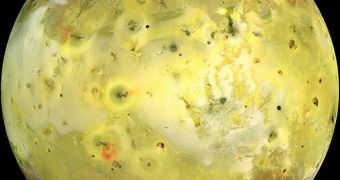The Jovian moon Io is one of the most promising candidates for supporting life in the solar system. Other celestial bodies, such as Jupiter's Europa and the Saturnine moons Enceladus and Titan, are also good candidates, but only Io could potentially support extreme lifeforms.
One of the things that separate this body from any other in the solar system, including Earth, is the fact that almost all of its surface is covered in active volcanoes. Hundreds of them are active at the same time, whereas only a handful erupt on our planet any given day.
When large volcanoes on Io blow up, they sometimes throw plumes of debris up to 186 miles (300 kilometers) above the moon's surface. The portion of material that is recaptured by its gravity falls back to the surface, spraying itself over huge areas.
While not many would consider looking at Io as a potential home for various lifeforms, the fact remains that the body may have contained vast amounts of water when it first formed. If the moons Ganymede and Europa are any indication, then Io too must have had (and lost) a lot of ice.
The frozen water was present in its earliest days, astronomers now suggest. But, within as few as 10 million years, intense radiations from Jupiter may have stripped all the water from this moon, leaving it in its current state, Daily Galaxy reports.
Experts say that this would have given the object ample time to develop life to such an extent that organisms would have been able to move underground as water began disappearing. Given the propensity life has for survival and adaptation, the idea is not farfetched at all.
In fact, it's the same assumption that underlies the quest for life on Mars. Our neighboring planet also had a friendly climate in the past, and ample time to allow life to develop before things went sour.
“Life on the surface [of Io] is all but impossible, but if you go down further into the rocks, it could be intriguing. We shouldn't categorize it as dead right away just because it's so extreme,” Washington State University astrobiologist Dirk Schulze-Makuch explains.
Life would, for example, find it very easy to endure inside Io's numerous lava tubes. Such structures can trap moisture and chemicals such as sulfurous compounds, to be used as food. They also provide thermal insulation, and shield anything within from the harmful effect of Jupiter's radiations.
On Earth, lava tubes are home to numerous species of extremophiles, species of microorganisms that are accustomed to living in conditions that would kill any other lifeform. Similar tunnels exist on the Moon and Mars as well, and they will represent targets for upcoming space exploration missions.
Due to Io's weird orbit around Jupiter, life may only be able to endure inside the tunnels for short periods of time. Microorganisms could spend prolonged periods in slumber, hibernating until conditions are sufficiently favorable to warrant their awakening.
This could be the case, for example, when sufficient sulfurous compounds are gathered inside the lava tunnels. Such an event may occur only once per each orbit Io carried out around Jupiter. Under such circumstances, lifeforms may spend the rest of each orbit – the equivalent of many Earth years – sleeping.

 14 DAY TRIAL //
14 DAY TRIAL //